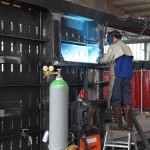Welding fumes and their varying effects
Not all welding fumes are the same. Hazardous substances created by the welding process have different effects on the human body. There are substances which affect the lungs, poisonous substances and carcinogenic substances – and they all harbor their own special dangers.
Substances that place strain on respiratory tract and lungs
This category includes, for example, aluminum, iron or magnesium oxides. When welding is carried out using these substances, the welding fumes created can result in damage to the respiratory tract and the lungs if they are inhaled over a long period. This results in respiratory diseases such as bronchitis, or narrowing of the airways. In the case of iron oxides, additional dust deposits can occur in the lungs in the form of siderosis (haemochromatosis). High quantities of welding fumes can even result in fibrogenic reactions (conjunctive tissue augmentation) in the lungs.
Toxic substances
Toxic substances have an effect on the body when a certain dose is exceeded. This limit value is mainly dependent on the bodyweight of the affected person. Some examples of toxic substances are gases such as carbon monoxide, nitrogen oxide, ozone or the oxides produced by the metals copper, lead and zinc. Low levels of poisoning cause minor health problems. Allowing yourself to be exposed to high concentrations of these substances can cause life-threatening poisoning which can even result in death.
Cancer-causing carcinogenic substances
Carcinogenic substances can result in malignant tumors. Such substances include chrome (VI) compounds, nickel oxide or cobalt oxide. However, the following should be considered: the cancer risk is dependent on many factors such as genetics or environmental influences, and can therefore not be clearly determined. It has, however, been proven that increasing doses of such substances increase the cancer risk. Apart from this, there is no specific value below which there is no hazards. Cancer-causing substances are therefore potentially dangerous to health in any dose. They are classified in several categories in the German Technischen Regel für Gefahrstoffe 905 (TRGS) [Technical Regulations for Hazardous Substances]. The first three categories are the most important:
- Category 1:
Substances known to be carcinogenic (sufficient indications)
- Category 2:
Substances considered to be carcinogenic (justified indications)
- Category 3:
Substances of very high concern with proven or possible carcinogenic effects which, however, cannot be definitively assessed.





